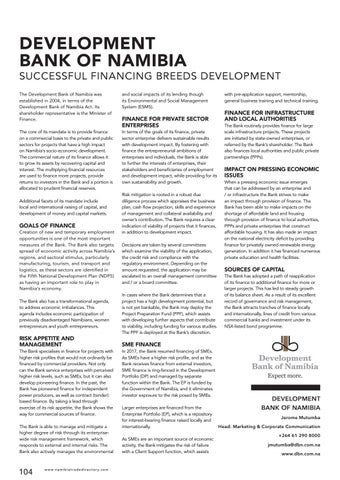DEVELOPMENT BANK OF NAMIBIA
SUCCESSFUL FINANCING BREEDS DEVELOPMENT The Development Bank of Namibia was established in 2004, in terms of the Development Bank of Namibia Act. Its shareholder representative is the Minister of Finance.
and social impacts of its lending though its Environmental and Social Management System (ESMS).
The core of its mandate is to provide finance on a commercial basis to the private and public sectors for projects that have a high impact on Namibia’s socio-economic development. The commercial nature of its finance allows it to grow its assets by recovering capital and interest. The multiplying financial resources are used to finance more projects, provide returns to investors in the Bank and a portion is allocated to prudent financial reserves.
In terms of the goals of its finance, private sector enterprise delivers sustainable results with development impact. By fostering with finance the entrepreneurial ambitions of enterprises and individuals, the Bank is able to further the interests of enterprises, their stakeholders and beneficiaries of employment and development impact, while providing for its own sustainability and growth.
Additional facets of its mandate include local and international raising of capital, and development of money and capital markets.
GOALS OF FINANCE
Creation of new and temporary employment opportunities is one of the most important measures of the Bank. The Bank also targets spread of economic activity across Namibia’s regions, and sectoral stimulus, particularly manufacturing, tourism, and transport and logistics, as these sectors are identified in the Fifth National Development Plan (NDP5) as having an important role to play in Namibia’s economy. The Bank also has a transformational agenda, to address economic imbalances. This agenda includes economic participation of previously disadvantaged Namibians, women entrepreneurs and youth entrepreneurs.
RISK APPETITE AND MANAGEMENT
The Bank specialises in finance for projects with higher risk profiles that would not ordinarily be financed by commercial providers. Not only can the Bank service enterprises with perceived higher risk levels, such as SMEs, but it can also develop pioneering finance. In the past, the Bank has pioneered finance for independent power producers, as well as contract (tender) based finance. By taking a lead through exercise of its risk appetite, the Bank shows the way for commercial sources of finance. The Bank is able to manage and mitigate a higher degree of risk through its enterprisewide risk management framework, which responds to external and internal risks. The Bank also actively manages the environmental
104
w w w. n a m i b i a t r a d e d i r e c t o r y. c o m
FINANCE FOR PRIVATE SECTOR ENTERPRISES
Risk mitigation is rooted in a robust due diligence process which appraises the business plan, cash flow projection, skills and experience of management and collateral availability and owner’s contribution. The Bank requires a clear indication of viability of projects that it finances, in addition to development impact. Decisions are taken by several committees which examine the viability of the application, the credit risk and compliance with the regulatory environment. Depending on the amount requested, the application may be escalated to an overall management committee and / or a board committee. In cases where the Bank determines that a project has a high development potential, but is not yet bankable, the Bank may deploy the Project Preparation Fund (PPF), which assists with developing further aspects that contribute to viability, including funding for various studies. The PPF is deployed at the Bank’s discretion.
with pre-application support, mentorship, general business training and technical training.
FINANCE FOR INFRASTRUCTURE AND LOCAL AUTHORITIES
The Bank routinely provides finance for large scale infrastructure projects. These projects are initiated by state-owned enterprises, or referred by the Bank’s shareholder. The Bank also finances local authorities and public private partnerships (PPPs).
IMPACT ON PRESSING ECONOMIC ISSUES
When a pressing economic issue emerges that can be addressed by an enterprise and / or infrastructure the Bank strives to make an impact through provision of finance. The Bank has been able to make impacts on the shortage of affordable land and housing through provision of finance to local authorities, PPPs and private enterprises that construct affordable housing. It has also made an impact on the national electricity deficit by providing finance for privately owned renewable energy generation. In addition it has financed numerous private education and health facilities.
SOURCES OF CAPITAL
The Bank has adopted a path of reapplication of its finance to additional finance for more or larger projects. This has led to steady growth of its balance sheet. As a result of its excellent record of governance and risk management, the Bank attracts tranches of finance locally and internationally, lines of credit from various commercial banks and investment under its NSX-listed bond programme.
SME FINANCE
In 2017, the Bank resumed financing of SMEs. As SMEs have a higher risk profile, and as the Bank receives finance from external investors, SME finance is ring-fenced in the Development Portfolio (DP) and managed by separate function within the Bank. The EP is funded by the Government of Namibia, and it eliminates investor exposure to the risk posed by SMEs. Larger enterprises are financed from the Enterprise Portfolio (EP), which is a repository for interest-bearing finance raised locally and internationally. As SMEs are an important source of economic activity, the Bank mitigates the risk of failure with a Client Support function, which assists
DEVELOPMENT BANK OF NAMIBIA Jerome Mutumba Head: Marketing & Corporate Communication +264 61 290 8000 jmutumba@dbn.com.na www.dbn.com.na
